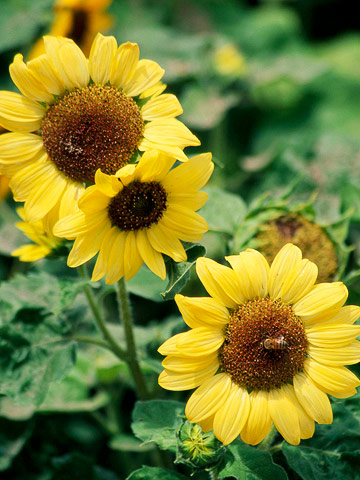






Sunflowers grow as short as 16 inches or more than 14 feet tall in myriad warm colors ranging from reds to yellows to oranges to bronzes. The world record for tallest sunflower is just over 30 feet!
These easy-to-grow annuals (their scientific name is Helianthus annuus) not only look cheerful when planted in the garden or cut for a bouquet, they charmingly turn their flower heads to follow the sun. Some varieties are grown specifically as cut flowers, but many types produce delicious edible seeds.
Click here for suggestions on which varieties to plant and their garden companions.
continue reading belowChoose a location in full sun. Plant sunflowers after all danger of frost has passed. Scratch compost or a time-release fertilizer into the soil.
The large black seeds are easy for children to handle. Begin by planting sunflower seeds 1/2 to 1 inch deep -- at the depth recommended on the package -- and spacing them accordingly.
After the seedlings emerge, thin or transplant the plants to allow enough room for your type to grow. Some of the largest sunflowers need 12 to 18 inches between each plant.
Sunflower plants should receive 1 inch of rain or supplemental water each week.
Plant sunflower seeds in a circle or square big enough for a child to enter when the plants are full-grown. Remember to pull out enough seedlings to give the plants room to grow. It's hard to yank out a growing sunflower plant, but it's necessary for the health of the ones that remain! Each week, you can measure the height of the sunflowers against the height of your child.
If you want a roof, plant scarlet runner beans, morning glories, or another lightweight vining plant with the sunflowers. The vines use the sturdy sunflower stems as a trellis and enclose the space even more.
To grow the biggest sunflowers, start with seeds of varieties bred to grow tall with thick stalks. Some of the giant sunflower varieties include: 'Sunzilla' (12 to 16 feet tall); 'Heirloom Titan' (12 to 14 feet); 'Russian Mammoth' (9 to 12 feet), 'American Giant' (up to 16 feet), 'Kong' (12 to 14 feet), and 'Giganteus' (12 to 14 feet). A clue to their size is often in their names. Stake tall sunflowers to protect them from wind damage.
Names are also clues to dwarf sunflowers, which can be grown in the ground or in a pot. Plant just one per 8- to 12-inch pot. Some of the smallest sunflower varieties include 'Junior' (2-1/2 feet tall), 'Sunny Smile' (15 to 20 inches), 'Teddy Bear' (2 to 3 feet with fuzzy petals), 'Sunny Bunch' (2 to 3 feet), 'Elf' (16 inches), and 'Little Becka' (3 feet and bicolor).
Some plants called sunflowers aren't the same species at all. Mexican sunflower (Tithonia rotundifolia) is a tough annual flower that's a butterfly and pollinator magnet. They grow in conditions similar to sunflowers and have rays of bright orange-red blooms extending from yellow centers.
There are many perennial sunflowers. Many go by the name of prairie sunflower: Helianthus petiolaris, Helianthus grosseserratus (also called sawtooth sunflower), Helianthus pauciflorus (showy sunflower), and Helianthus maximiliani (Maximilian sunflower). Check out varieties of perennial sunflowers here.
Copyright © www.100flowers.win Botanic Garden All Rights Reserved